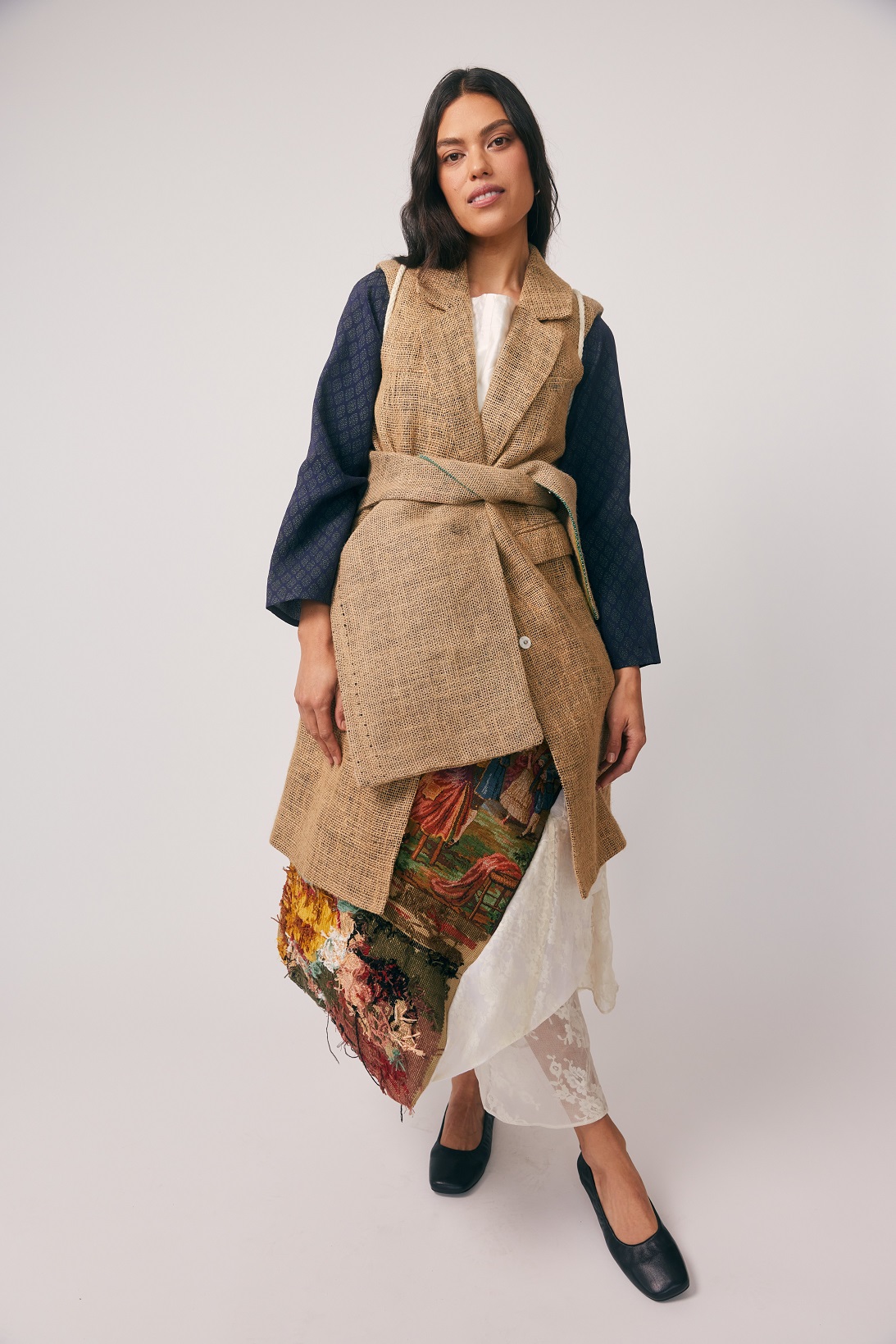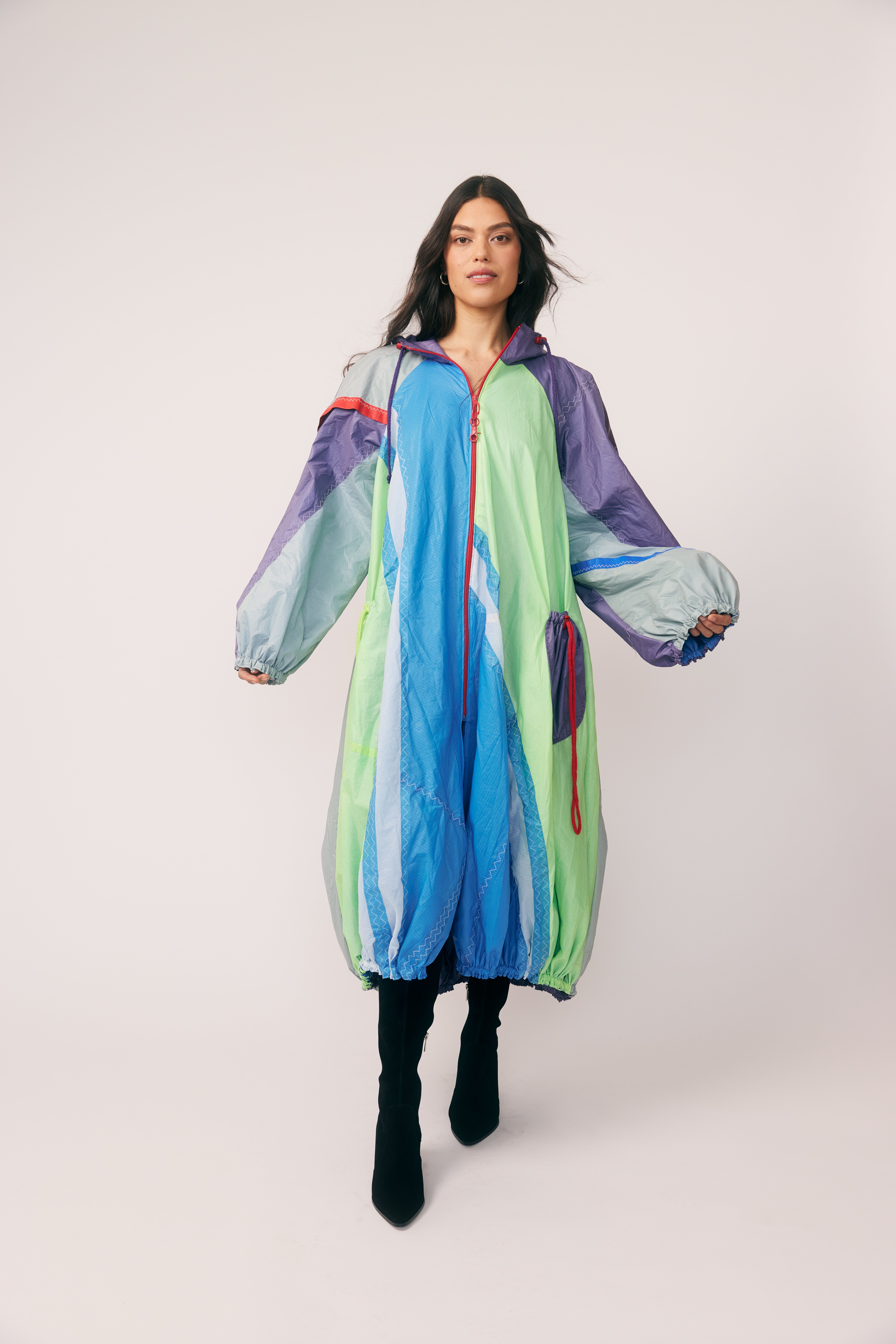
From covetable raincoats crafted from old sailcloths to outfits elevating coffee sacks, this year’s Mindful Fashion NZ Circular Design Awards winners have shown the future of sustainable fashion is full of potential — and far from boring.

"Our supreme winners treated their chosen textiles as precious resources and used them to produce an outcome of greater value, treating them not as a limitation but as a starting point for innovation," says Mindful Fashion NZ chief executive Jacinta FitzGerald.
This year the judging panel was extremely impressed by the overall high quality of work from entrants.
"Encouragingly, we noticed an increased focus on tackling industry and business waste streams and thoroughly enjoyed understanding how each designer had chosen to take on the challenge."
Winner of the 2024 Creative Excellence in Circular Design award Jacqueline Tsang tapped into a diverse fusion of fabrications — from coffee sacks sourced from local cafes to damaged kimonos and vintage tapestries — for her entry, which nods to her ancestors and draws inspiration from the nostalgia of places, customs and memories of her past.
"I grew up in Sham Shui Po, also known as the garment district, in Hong Kong," Tsang said.
"It’s full of fabric and little shops selling every kind of fastener, zip and snap you can imagine. The livelihoods and culture of the area are uniquely tied to the fashion industry."
Growing up in that community formed her earliest memories of fashion.
"The process of creating my entry took me on a journey through the history of the women in my family that came before me, specifically my grandmother: what she went through and what she meant to me.
"It’s dedicated to her memory, and all the other Hakka women like her."
Tsang began her career in fashion as a design assistant for an international lingerie design and manufacturing company based in Hong Kong. She studied at London’s prestigious Central St Martins while interning at Agent Provocateur and Mathew Williamson, before moving to New Zealand in 2015, and has since worked at Karen Walker, Rue de Seine and now Ruby as part of the development team.
"I also volunteered in hospice shops, which started my journey into the circular principles of the preloved/second-hand fundraising model, which led me to upcycling," says Tsang.
Once she joined Ruby, its focus on sustainability really opened her eyes to the potential of natural fibres and motivated her to enter the competition.
"To incorporate everything that I’ve learned to bring the highest possible level of garment construction and conceptual design, intertwined with my culture and story, I used natural and recycled fibres, along with fabric remnants, to reduce waste and promote sustainability. These materials connect back to my time at Ruby, where I learned how to combine high-quality fabrics with sustainable practices."

"The materials we take for granted are actually precious and this needs to inform the design process to incorporate the lifecycle of the garment and its materials. The fashion industry needs to return to a model where garments are treasured, mended, borrowed and passed down."
The judges’ notes said Tsang’s design "elevates the materials through use of craft techniques and creative design elements and weaves them together with the designer’s story of connection to place, resulting in a high fashion luxury outfit showing a high level of attention to detail and construction".
Designed to offer protection from Wellington's famously unpredictable weather and cut from 95% locally sourced sail-cloth waste, Sue Prescott’s "Southerly Change" was the winner of the Material Innovation award.
"The key material used in the coat was old nylon spinnaker sails," Prescott said.
"I identified a waste stream that would enable me to design for longevity as well as for low-impact materials. Although lightweight, this nylon fabric is strong and exhibits good UV stability. The large pieces of cloth enable versatility, for potential remaking into smaller items during the lifetime of the fabric, even when the garment has reached the end of its life. Although not compostable, there are companies that recycle nylon fabric into new fabric without leaving a carbon footprint, for a carbon neutral outcome."
Currently working as a fashion and costume designer and lecturer at Massey University’s School of Design, Prescott gained a fashion/textile degree in the UK before starting out as a textile designer, designing lace for both fashion and interiors.

"As a creative practitioner and educator, repair, reuse and avoiding waste are central to my existence. I thrive on breathing new life into discarded materials, transforming them into innovative new materials and to use in the design process for clothing. I am committed to environmental stewardship, and to educating fashion consumers on the importance of circular thinking."
Prescott says she enjoys the challenge of working with non-orthodox materials for her winning entry.
"Embracing the imperfections is a necessary aspect of repurposing fabrics with a former life. A solutions-focused approach enabled me to plan the garment around any tears and damaged areas of the sails. I really loved utilising the traditional three-step zigzag sailmaker’s stitching where it was still in good shape, and emulating that where possible as I constructed the coat."
She says the large scale of the sailcloth pieces posed the greatest challenge, "as it wasn't feasible to lay out the entire fabric to assess how best to position my pattern".
"As a result, I had to adopt an organic, piece-by-piece approach, carefully considering the alignment of seams and colour blocking to maintain a sense of coherence throughout the garment."
Those interested in owning something similar may be in luck, as Prescott says she’s currently looking forward to working with local fashion label Ruby to explore production opportunities.
Selected from a pool of emerging designers aged between 16 and 22, Ella Fidler’s "Scrap Yarn" won this year’s Excellence from a Rising Talent in Circular Design award.

"The feature item is a vest made from pre-production fabric waste, where a new yarn has been created from scraps from the garment cutting process and constructed into a tailored vest, leaving raw edges that illustrate the origins of the material while elevating the design through choice of design elements to create a high fashion garment."
The young designer says her entry focused "on giving a purpose to fabric waste that’s created during the cutting stage of making a garment".
"I collected scraps, cut them into strips, and sewed them together to make a yarn that I used to crochet the vest. The shirt is made from an old bed sheet and the shorts are made from a larger piece of scrap material. All waste from making these was used to make the vest."
Currently doing a bachelor of design innovation at Victoria University, majoring in fashion and minoring in industrial design, Fidler says her interest in the industry was sparked early, and from a somewhat unconventional source.
"I've always liked reading books and would imagine what the characters were wearing in stories set in different times or in fantasy worlds," she says.
Of taking a more mindful approach, Fidler says because the fashion industry has a negative impact on the environment, she thinks it is important to make fashion more sustainable, so that it can have a more positive future.
"This is very important to me as a student who wants to have a future in the fashion industry without causing more harm to the environment."
As well as getting set to graduate next year, Fidler says she’s currently making a collection inspired by fantasy character archetypes, using discarded textiles, that she plans to show at Te Wiki Āhua o Aotearoa (Auckland’s "underground" fashion week) in March.












